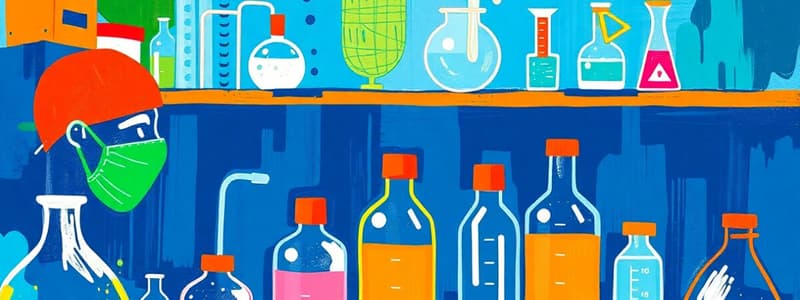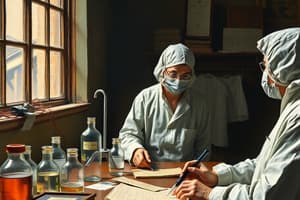Podcast
Questions and Answers
What is strictly forbidden in the laboratory environment?
What is strictly forbidden in the laboratory environment?
- Eating food (correct)
- Wearing gloves
- Wearing a lab coat
- Using laboratory equipment
Why is the use of contact lenses prohibited in the laboratory?
Why is the use of contact lenses prohibited in the laboratory?
- They can obstruct vision
- They may dry out and require surgery to remove (correct)
- They are prone to damage from chemicals
- They can cause allergic reactions
What type of safety gear must a student wear at all times in the laboratory?
What type of safety gear must a student wear at all times in the laboratory?
- Lab coat and goggles (correct)
- Goggles and gloves
- Goggles and jewelry
- Lab coat and sandals
What can long hair pose in a laboratory setting?
What can long hair pose in a laboratory setting?
What should students do if they are unsure about safety protocols?
What should students do if they are unsure about safety protocols?
Which item is recommended to be stored in a specific pouch or bag after use?
Which item is recommended to be stored in a specific pouch or bag after use?
Why is wearing jewelry in the laboratory discouraged?
Why is wearing jewelry in the laboratory discouraged?
What is the responsibility of participants in the laboratory regarding safety?
What is the responsibility of participants in the laboratory regarding safety?
What should be done with broken glassware?
What should be done with broken glassware?
Under what conditions should experiments that create fumes be conducted?
Under what conditions should experiments that create fumes be conducted?
If a large fire ignites in the lab, what is the first action you should take?
If a large fire ignites in the lab, what is the first action you should take?
What is prohibited regarding the handling of chemicals?
What is prohibited regarding the handling of chemicals?
Which safety equipment must a student know the location of and how to use?
Which safety equipment must a student know the location of and how to use?
What must be done in case of a chemical spill on the floor?
What must be done in case of a chemical spill on the floor?
Which of the following statements about the use of water as an extinguisher is correct?
Which of the following statements about the use of water as an extinguisher is correct?
How should lab technicians and students handle a small wound?
How should lab technicians and students handle a small wound?
What is a safe practice when heating a substance in a test tube?
What is a safe practice when heating a substance in a test tube?
What is the minimum passing mark required in the safety rules examination?
What is the minimum passing mark required in the safety rules examination?
Flashcards are hidden until you start studying
Study Notes
Lab Safety Introduction
- The lab is dangerous when safety protocols are not followed.
- Participants are responsible for their own safety and the safety of others in the laboratory.
- Ignorance of lab safety rules is not acceptable.
- If you are unsure about safety, ask your instructor or lab technician.
General Safety Rules
- Food and smoking are strictly prohibited in the laboratory.
- Lab coats and goggles must be worn at all times when in the lab.
- Lab coats should be stored in a designated pouch or bag after use.
- Contact lenses are prohibited in the laboratory.
- Wear appropriate gloves for various chemicals.
- Sandals are prohibited.
- Keep long hair tied back and away from chemicals.
- Do not wear jewelry.
- Avoid wearing a watch.
- Do not bring radio, headphones, etc. into the laboratory.
- Use both hands to carry items in the lab (e.g., glassware).
- Never touch broken glass with your hands.
- Dispose of broken glassware in the designated receptacle, not the regular waste bin.
- Everyone must know the location and use of the first aid kit, fire extinguishers, and emergency showers.
- Safety equipment must be maintained and not used unnecessarily.
- Do not smell directly from bottles and avoid inhaling vapors.
- Open containers containing chemicals within a fume hood.
- Experiments that produce fumes should always be conducted in a fume hood.
- Avoid chemical contact with eyes and mucous membranes.
- In case of a large chemical spill, inform the lab technician immediately.
- Shorts or skirts above the knee are not allowed in the laboratory.
- Inform the lab technician immediately in case of danger or accidents.
- If a chemical in a beaker or flask catches fire, cover the flame with a beaker or damp cloth (only if the fire is small).
- Use the appropriate fire extinguisher and fire blanket for larger fires.
- For a large fire, evacuate the lab and alert other buildings.
- Call the Fire Department.
- Gather at the designated assembly point in case of fire.
- Water is effective for fire-related materials like wood, paper, cloth, and plastic but is not effective for electrical fires or flammable liquids.
General Safety Rules for Chemical Reagents
- Work with hazardous reagents only in the fume hood.
- Do not pipette by mouth.
- Use rubber suckers (bulbs) for proper pipetting.
- Use only the required amount of reagents in the experiment.
- Do not return excess reagent to the container (consult the lab technician for disposal).
- Do not heat flammable liquids or solutions in open containers or with Bunsen burners.
Laboratory Waste
- Do not pour chemical waste into sinks or regular trash bins.
- Chemical waste must be collected in designated containers and delivered to a collection company for neutralization.
- Avoid mixing incompatible chemicals to prevent dangerous reactions.
Toxic Substances
- Treat all chemicals as potential poisons unless otherwise indicated.
- If you sustain a small cut, let the blood flow for a few seconds, disinfect the wound, and bandage it.
Carcinogens
- Metallic mercury vapors and volatile compounds are dangerous poisons.
- If working with known carcinogenic compounds, avoid inhaling fumes or contact with the skin.
Other Safety Issues
- Discuss incomplete lab experiments with the lab technician/instructor.
- When heating a substance in a test tube, point the mouth away from other people.
- Use clamps or tongs to handle hot glassware.
Exam for Lab Safety
- A lab safety exam is required (80% or higher passing score) before starting lab courses.
- The exam consists of 30 multiple-choice and/or true/false questions.
- The exam will be held on October 9th, 2024 at 2:00 p.m..
Studying That Suits You
Use AI to generate personalized quizzes and flashcards to suit your learning preferences.




